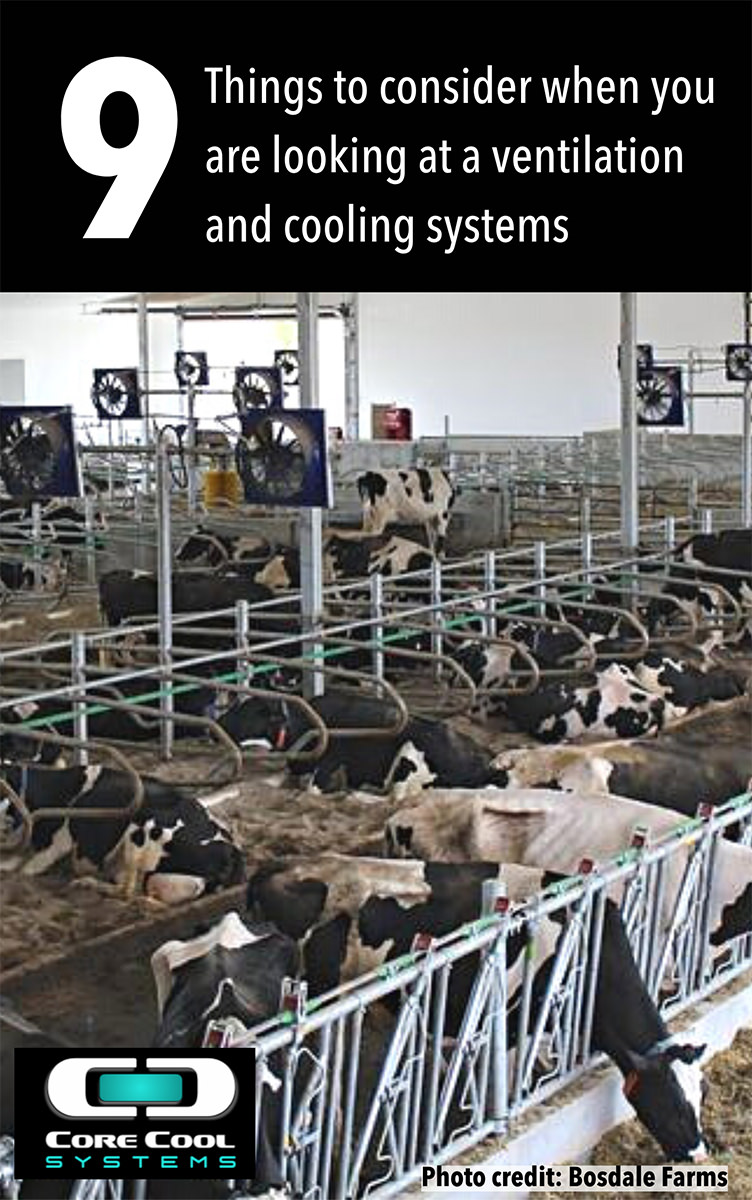
Understanding THI and Its Impact on Dairy Cows Throughout Their Life.
As temperatures rise, dairy farmers face significant challenges in maintaining the health and productivity of their herds. Heat stress is a critical concern, and understanding the Temperature Humidity Index (THI) is key to mitigating its impact. High THI levels lead to heat stress, adversely affecting calves, heifers, dry cows, transition cows, and lactating cows.
This article delves into THI, its effects on dairy cows at different stages of their life, and how Core Cool Systems can help keep your cows comfortable and productive.
What is THI?
THI, or Temperature Humidity Index, is a composite measure that combines air temperature and humidity to assess the risk of heat stress in dairy cows. It provides a more accurate indicator of heat stress risk than temperature alone. When THI rises, cows experience increased heat stress, which can lead to significant health and productivity issues.
How to Calculate THI
There are a few formulas to calculate THI:
Example: THI= T - 0.55 x (1 - H/100) x (T-58)
Where: T is the air temperature in degrees Fahrenheit.
H is the relative humidity as a percentage.
You don't enjoy doing math every day? No problem! You can use a handy THI chart to find out your THI. Simply take the temperature and humidity from the side and top of the chart. Follow the lines, and where they meet is your THI. The results are color-coordinated to help you identify the level of heat stress your cows are experiencing based on the THI.
Why should you know your THI?
- THI helps determine the level of heat stress cows may be experiencing.
- Heat stress begins to impact your cows at a THI of 68.
- High THI levels lead to heat stress, which adversely affects calves, heifers, dry cows, transition cows, and lactating cows.
- Damage done by high THI can’t be undone.
Now that you know your THI, what does it mean to your cows?
THI 68 - 72 - Mild Heat Stress
Core Body Temperature: Slight increase to 102.2°F (39°C).
Signs: Increased respiration rate (60 - 80 breaths per minute), slightly reduced feed intake, mild discomfort.
Impact: Minor decline in milk production; early signs of stress.
THI 72 - 79 - Moderate Heat Stress
Core Body Temperature: Rises to 102.5 - 103°F (39.2 - 39.4°C).
Signs: Rapid breathing (80 - 100 breaths per minute), noticeable panting, reduced feed intake.
Impact: Moderate drop in milk production, reduced fertility.
THI 80 - 89 - Severe Heat Stress
Core Body Temperature: 103-104°F (39.4-40°C).
Signs: Heavy panting (over 100 breaths per minute), open-mouth breathing, a significant reduction in feed and water intake.
Impact: Severe decline in milk production, major reproductive issues.
THI 90 -99 - Extreme Heat Stress
Core Body Temperature: Exceeds 104°F (40°C), approaching 105°F (40.6°C) or higher.
Signs: Extreme panting (120+ breaths per minute), potential collapse, very high water intake.
Impact: Critical drop in milk production, severe health risks, high mortality risk.
THI exceeding 100 -
Core Body Temperature: Cows may experience core body temperatures exceeding 106°F (41.2°C), leading to severe heat exhaustion and potential collapse.
Signs: Extreme panting (130+ breaths per minute)
Impact: Potentially fatal conditions, dehydration, metabolic disorders like ketosis.
The THI impacts animals at every stage of their lives.
Calves and Heifers
Impact on Calves In Utero (during pregnancy):
- Reduced fetal growth due to decreased feed intake and nutrient absorption, potentially resulting in smaller, weaker calves.
- Increased risk of pregnancy loss (abortions) caused by elevated temperatures and stress hormones.
- Compromised immune systems in both mother and fetus, increasing vulnerability to diseases.
- Long-term impacts on calf health and productivity, including slower growth and reduced disease resistance early in life.
Impact on Calves:
- Growth Rates: Heat stress in calves can lead to reduced feed intake, stunted growth, and compromised immune function.
- Health: High THI levels can cause dehydration, increased respiratory rates, and susceptibility to diseases.
Impact on Heifers:
- Development: Young heifers experiencing heat stress may exhibit slower growth and delayed puberty.
- Future Productivity: Early exposure to heat stress can impact future milk production and reproductive performance.
Lactating Cows
Impact on Milk Production:
- Reduced Milk Yield: Studies have shown that heat stress can reduce milk yield by 3.7 lb/day in heifers and 5.3 lb/day in mature cows. High THI levels (>72) significantly decrease dry matter intake (DMI), leading to lower milk production.
- Milk Composition: Heat stress can alter milk composition, reducing fat and protein content.
Impact on Reproduction:
- Conception Rates: Heat stress severely impacts reproductive efficiency. High THI levels lead to lower conception rates, increased pregnancy loss, and extended calving intervals.
- Hormonal Imbalance: Elevated temperatures disrupt hormonal balance, affecting ovulation and embryo development.
Dry and Transition Cows
Impact on Dry Cows:
- Health Issues: Heat stress during the dry period increases the risk of health problems such as retained placenta, metritis, and mastitis.
- Body Condition: Maintaining optimal body condition during the dry period is challenging under heat stress, leading to difficulties in the subsequent lactation.
Impact on Transition Cows:
- Metabolic Stress: Transition cows, those in the last three weeks of gestation and the first three weeks of lactation, are highly susceptible to heat stress. High THI levels exacerbate metabolic stress, leading to issues like ketosis and fatty liver.
- Calving Complications: Heat stress increases the likelihood of calving complications and negatively affects colostrum quality, impacting calf health.
Managing THI to Mitigate Heat Stress
Understanding the effects of THI is essential, but proactive management is crucial. Implementing strategies to maintain cows within their thermal comfort zone can significantly improve their health and productivity. Here are some key strategies:
- Monitoring THI: Regularly monitor the THI in your barn using reliable tools and technology. This helps in making informed decisions about when to implement cooling measures.
- Cooling Systems: Invest in advanced cooling systems like Core Cool Systems, which monitor barn conditions and adjust fan speed and water application based on real-time THI levels. These systems proactively maintain cow core body temperature, preventing heat stress.
- Ventilation: Ensure proper barn ventilation to facilitate air movement and reduce humidity. Adequate air intake and exhaust are a crucial component of cow cooling, airspeed at the feed bunk and at cows level in the beds is critical.
- Shade and Water: Provide ample shade and access to clean, cool water. Cows seek shade; it’s their natural behavior, and they need more. On hot days, a cow's intake can increase by 50%. The last thing anyone wants on a hot day is empty water troughs. Interesting fact: For every gallon of milk produced, a cow needs about 4 to 5 gallons of water.
- Nutritional Management: Adjust feeding practices during periods of high THI. Provide easily digestible, high-energy feeds to compensate for reduced intake. There are some great products on the market to help cows deal with the summer heat and humidity.
Real World, On-Farm "Cool Results"
Real world on-farm results 1: Successful Implementation of Cooling Systems A dairy farm in Solvenia implemented Core Cool Systems 4 summers ago to manage summer heat stress. Proactively adjusting fan speed and evaporative cooling systems based on real-time THI levels to maintain core body temperature and keep the cows' core body cool. The farm reported no drop in milk yield during the summer months and a significant improvement in reproduction. See some "Cool Results" from this operation.
Real world on-farm results 2: Improved Reproduction Rates A farm in Ontario focused on maintaining core body temperature (CBT) with Core Cool Systems. Using CattleScan technology to take real-time CBT readings, he found that even at THI of 85, he got zero Critical Temp 40.5C alerts and zero Sustained Temp alerts in his milk cows. Because of Core Cool Systems, they have maintained production and reproduction, highlighting the importance of investing in a system that focuses on maintaining core body temperature and adjusting according to the THI in the barn. See some amazing "Cool Results" from this operation.
Key Takeaway
Managing THI and mitigating heat stress is vital for the health, productivity, and reproductive efficiency of dairy cows. By understanding the impact of THI at each stage of a cow's life and implementing effective cooling strategies, farmers can ensure their herds remain comfortable, healthy, and productive. Investing in technologies like Core Cool Systems can help maintain optimal conditions, ultimately leading to better outcomes for both cows and dairy operations.
Stay proactive in managing heat stress to safeguard your herd's health and productivity. Monitor the THI and invest in a system that proactively adjusts to meet your cows' needs. Ensure your cows remain comfortable and cool.
If you are looking to invest in a system that:
- Focuses on your cow’s core body temperature
- Monitors the THI levels in your barn.
- Adjusts automatically to meet your cows needs based on the THI.
- Provides high-speed air at cow level both in their beds and at the feed bunk.
- Provides evaporative cooling adjusted according to the THI levels in your barn.
Consider Core Cool Systems. Our name says what we do, and with proven on-farm results since 2009, you can be confident in your decision to invest in technology that puts keeping your cow's core cool first.
🐄💤☀️ #DairyFarming #HeatStress #CoreCoolCows #THI
For more information on managing THI and preventing heat stress, visit our website, corecoolsystems.com or contact nancy@corecoolsystems.com. You can also learn more about Core Cool Systems from this overview presentation.
Let’s work together to keep your cows cool and productive, no matter the weather.

Share: https://www.corecoolsystems.com/blog/Blog47/Understanding-THI-and-Its-Impact-on-Dairy-Cows-Throughout-Their-Life
Share Category "Cooling Cows":
https://www.corecoolsystems.com/blog/BlogCategory5/Cooling-Cows

